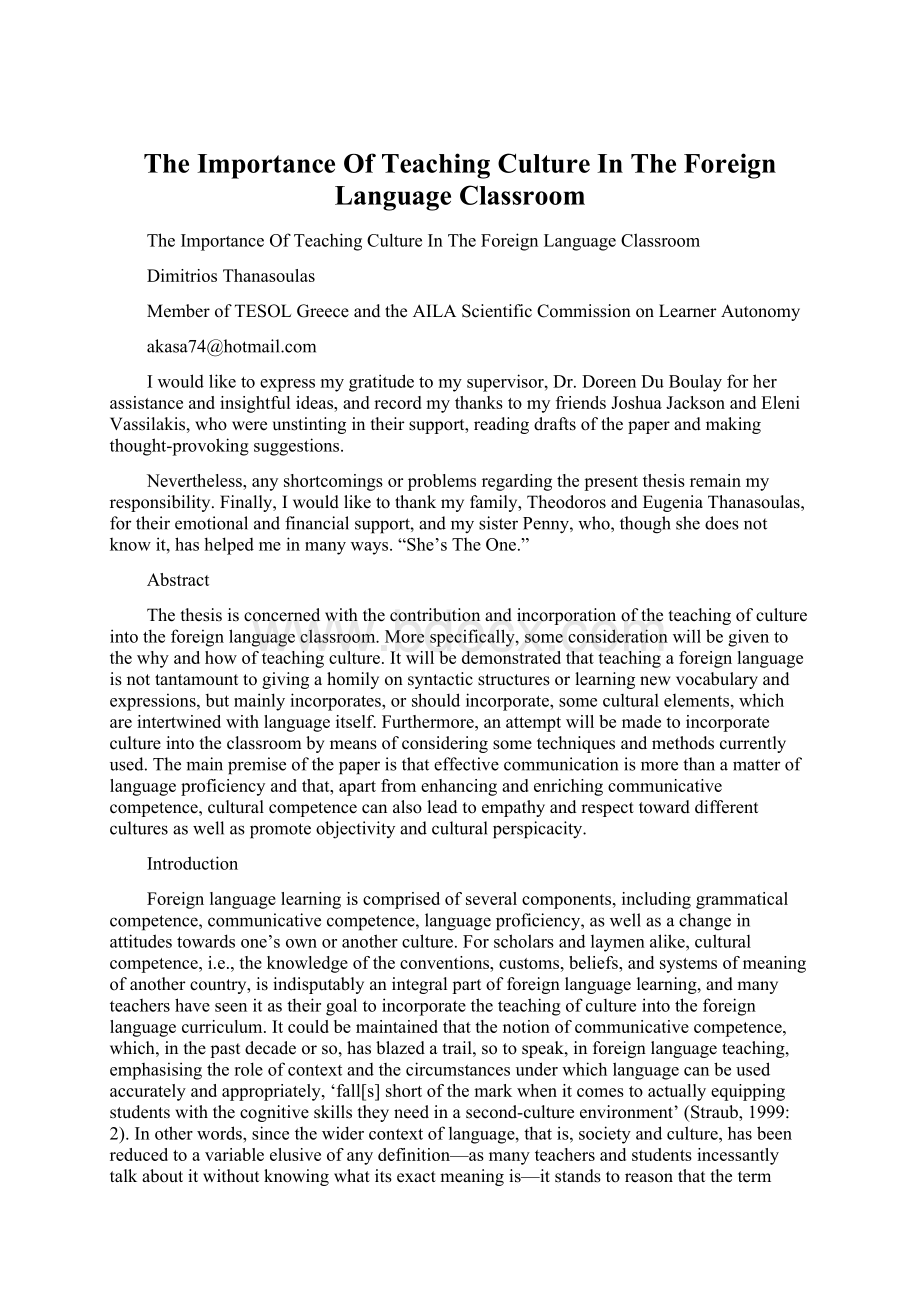The Importance Of Teaching Culture In The Foreign Language Classroom.docx
《The Importance Of Teaching Culture In The Foreign Language Classroom.docx》由会员分享,可在线阅读,更多相关《The Importance Of Teaching Culture In The Foreign Language Classroom.docx(23页珍藏版)》请在冰豆网上搜索。

TheImportanceOfTeachingCultureInTheForeignLanguageClassroom
TheImportanceOfTeachingCultureInTheForeignLanguageClassroom
DimitriosThanasoulas
MemberofTESOLGreeceandtheAILAScientificCommissiononLearnerAutonomy
akasa74@
Iwouldliketoexpressmygratitudetomysupervisor,Dr.DoreenDuBoulayforherassistanceandinsightfulideas,andrecordmythankstomyfriendsJoshuaJacksonandEleniVassilakis,whowereunstintingintheirsupport,readingdraftsofthepaperandmakingthought-provokingsuggestions.
Nevertheless,anyshortcomingsorproblemsregardingthepresentthesisremainmyresponsibility.Finally,Iwouldliketothankmyfamily,TheodorosandEugeniaThanasoulas,fortheiremotionalandfinancialsupport,andmysisterPenny,who,thoughshedoesnotknowit,hashelpedmeinmanyways.“She’sTheOne.”
Abstract
Thethesisisconcernedwiththecontributionandincorporationoftheteachingofcultureintotheforeignlanguageclassroom.Morespecifically,someconsiderationwillbegiventothewhyandhowofteachingculture.Itwillbedemonstratedthatteachingaforeignlanguageisnottantamounttogivingahomilyonsyntacticstructuresorlearningnewvocabularyandexpressions,butmainlyincorporates,orshouldincorporate,someculturalelements,whichareintertwinedwithlanguageitself.Furthermore,anattemptwillbemadetoincorporatecultureintotheclassroombymeansofconsideringsometechniquesandmethodscurrentlyused.Themainpremiseofthepaperisthateffectivecommunicationismorethanamatteroflanguageproficiencyandthat,apartfromenhancingandenrichingcommunicativecompetence,culturalcompetencecanalsoleadtoempathyandrespecttowarddifferentculturesaswellaspromoteobjectivityandculturalperspicacity.
Introduction
Foreignlanguagelearningiscomprisedofseveralcomponents,includinggrammaticalcompetence,communicativecompetence,languageproficiency,aswellasachangeinattitudestowardsone’sownoranotherculture.Forscholarsandlaymenalike,culturalcompetence,i.e.,theknowledgeoftheconventions,customs,beliefs,andsystemsofmeaningofanothercountry,isindisputablyanintegralpartofforeignlanguagelearning,andmanyteachershaveseenitastheirgoaltoincorporatetheteachingofcultureintotheforeignlanguagecurriculum.Itcouldbemaintainedthatthenotionofcommunicativecompetence,which,inthepastdecadeorso,hasblazedatrail,sotospeak,inforeignlanguageteaching,emphasisingtheroleofcontextandthecircumstancesunderwhichlanguagecanbeusedaccuratelyandappropriately,‘fall[s]shortofthemarkwhenitcomestoactuallyequippingstudentswiththecognitiveskillstheyneedinasecond-cultureenvironment’(Straub,1999:
2).Inotherwords,sincethewidercontextoflanguage,thatis,societyandculture,hasbeenreducedtoavariableelusiveofanydefinition—asmanyteachersandstudentsincessantlytalkaboutitwithoutknowingwhatitsexactmeaningis—itstandstoreasonthatthetermcommunicativecompetenceshouldbecomenothingmorethananemptyandmeretriciousword,resortedtoiffornootherreasonthantomakean“educationalpoint.”Inreality,whatmostteachersandstudentsseemtolosesightofisthefactthat‘knowledgeofthegrammaticalsystemofalanguage[grammaticalcompetence]hastobecomplementedbyunderstanding(sic)ofculture-specificmeanings[communicativeorratherculturalcompetence]’(Byram,Morganetal.,1994:
4).
Ofcourse,wearelongpastanerawhenfirstlanguageacquisitionandsecondorforeignlanguagelearningwerecastina“behaviouristicmould,”beingtheproductsofimitationandlanguage“drills,”andlanguagewasthoughtofasacompendiumofrulesandstringsofwordsandsentencesusedtoformpropositionsaboutastateofaffairs.Inthelasttwodecades,therehasbeenaresurgenceofinterestinthestudyoflanguageinrelationtosociety,whichhasledtoashiftoffocusfrombehaviourismandpositivismtoconstructivismtocriticaltheory(seeBenson&Voller,1997:
19-25).Yet,therearestillsomedeeplyingrainedbeliefsastothenatureoflanguagelearningandteaching—beliefsthatdeterminemethodologyaswellasthecontentoftheforeignlanguagecurriculum—whichhave,graduallyandinsidiously,contrivedtounderminetheteachingofculture.
Oneofthemisconceptionsthathavepermeatedforeignlanguageteachingistheconvictionthatlanguageismerelyacodeand,oncemastered—mainlybydintofsteepingoneselfintogrammaticalrulesandsomeaspectsofthesocialcontextinwhichitisembedded—‘onelanguageisessentially(albeitnoteasily)translatableintoanother’(Kramsch,1993:
1).Toacertainextent,thisbeliefhasbeeninstrumentalinpromotingvariousapproachestoforeignlanguageteaching—pragmatic,sociolinguistic,andcommunicative—whichhavecertainlyendowedthestudyoflanguagewithasocial“hue”;nevertheless,payinglipservicetothesocialdynamicsthatundergirdlanguagewithouttryingtoidentifyandgaininsightsintotheveryfabricofsocietyandculturethathavecometochargelanguageinmanyandvariedwayscanonlycausemisunderstandingandleadtocross-culturalmiscommunication.
Atanyrate,foreignlanguagelearningisforeignculturelearning,and,inoneformoranother,culturehas,evenimplicitly,beentaughtintheforeignlanguageclassroom—iffordifferentreasons.Whatisdebatable,though,iswhatismeantbytheterm“culture”andhowthelatterisintegratedintolanguagelearningandteaching.Kramsch’skeenobservationshouldnotgounnoticed:
Cultureinlanguagelearningisnotanexpendablefifthskill,tackedon,sotospeak,totheteachingofspeaking,listening,reading,andwriting.Itisalwaysinthebackground,rightfromdayone,readytounsettlethegoodlanguagelearnerswhentheyexpectitleast,makingevidentthelimitationsoftheirhard-woncommunicativecompetence,challengingtheirabilitytomakesenseoftheworldaroundthem.(Kramsch,1993:
1)
Theteachingofcultureisnotakintothetransmissionofinformationregardingthepeopleofthetargetcommunityorcountry—eventhoughknowledgeabout(letaloneexperienceof)the“targetgroup”isanimportantingredient(seeNostrand,1967:
118).Itwouldbenothingshortofludicroustoassertthatcultureismerelyarepositoryoffactsandexperiencestowhichonecanhaverecourse,ifneedbe.Furthermore,whatKramschherselfseemstoinsinuateisthattolearnaforeignlanguageisnotmerelytolearnhowtocommunicatebutalsotodiscoverhowmuchleewaythetargetlanguageallowslearnerstomanipulategrammaticalforms,sounds,andmeanings,andtoreflectupon,orevenflout,sociallyacceptednormsatworkbothintheirownorthetargetculture.
Thereisdefinitelymorethanmeetstheeye,andthepresentpaperhastheaimofunravellingthe“mystery,”sheddingsomelightontheroleofteachingcultureinfosteringcross-culturalunderstandingwhichtranscendstheboundariesoflinguisticforms—whileenrichingandgivingfardeepermeaningtowhatisdubbed“communicativecompetence”—andrunscountertoasolipsisticworldview.Iwouldliketoshowthattheteachingofculturehasenjoyedfarless“adulation”thanitmerits,andconsiderwaysofincorporatingitnotonlyintotheforeignlanguagecurriculumbutalsointolearners’repertoireandoutlookonlife.Themainpremiseofthispaperisthatwecannotgoaboutteachingaforeignlanguagewithoutatleastofferingsomeinsightsintoitsspeakers’culture.Bythesametoken,wecannotgoaboutfostering“communicativecompetence”withouttakingintoaccountthedifferentviewsandperspectivesofpeopleindifferentcultureswhichmayenhanceoreveninhibitcommunication.Afterall,communicationrequiresunderstanding,andunderstandingrequiressteppingintotheshoesoftheforeignerandsiftingherculturalbaggage,whilealways‘putting[thetarget]cultureinrelationwithone’sown’(Kramsch,1993:
205).Moreover,weshouldbecognisantofthefactthat‘[i]fweteachlanguagewithoutteachingatthesametimethecultureinwhichitoperates,weareteachingmeaninglesssymbolsorsymbolstowhichthestudentattachesthewrongmeaning…’(Politzer,1959:
100-101).
TheHistoryOFCultureTeaching
Aswillbecomeevident,theroleofculturallearningintheforeignlanguageclassroomhasbeentheconcernofmanyteachersandscholarsandhassparkedconsiderablecontroversy,yetitsvalidityasanequalcomplementtolanguagelearninghasoftenbeenoverlookedorevenimpugned.Uptonow,twomainperspectiveshaveinfluencedtheteachingofculture.Onepertainstothetransmissionoffactual,culturalinformation,whichconsistsinstatisticalinformation,thatis,institutionalstructuresandotheraspectsofthetargetcivilisation,highbrowinformation,i.e.,immersioninliteratureandthearts,andlowbrowinformation,whichmayfocusonthecustoms,habits,andfolkloreofeverydaylife(seeKramsch,1993:
24).Thispreoccupationwithfactsratherthanmeanings,though,leavesmuchtobedesiredasfarasanunderstandingofforeignattitudesandvaluesisconcerned,andvirtuallyblindfoldslearnerstotheminutealbeitsignificantaspectsoftheirownaswellasthetargetgroup’sidentitythatarenoteasilydivinedandappropriated(ibid.)Allthatitoffersis‘merebookknowledgelearnedbyrote’(Huebener,1959:
177).Theotherperspective,drawinguponcross-culturalpsychologyoranthropology,hasbeentoembedculturewithinaninterpretiveframeworkandestablishconnections,namely,pointsofreferenceordeparture,betweenone’sownandthetargetcountry.Thisapproach,however,hascertainlimitations,